|
 |
| |
The biodiversity of New Zealandís streams, rivers, lakes and former wetlands evolved from reliable rainfall that sustained rainforest throughout a long history. The freshwater fauna is significant historically, because it depends on fresh, clear, cool, flowing water. Freshwater ecosystems have been severely altered by removal of native forest that covered and protected the water habitat, introduction of predatory trout, and draining 90 percent of wetlands.
The indigenous bird fauna was once better represented. Seven species of duck, 2 geese, and 7 rails, 16 species altogether, are extinct partly because they were too tasty and too easily caught by humans and predatory animals. Of the remaining 5 native ducks, only blue duck and scaup are protected - the other 3 are still hunted. The freshwater fish fauna is also sparse with 41 native species in 9 families, but unique with half of the fauna diadromus, and 23 Galaxiid species.
|
| |
|
|
|
The endemic blue duck is threatened with a listing of 'nationally vulnerable'. It is one of only three species of torrent duck in the world. Blue duck were once commonly found on rivers and streams throughout New Zealand, but are now restricted to upland catchments in the Central North Island, Kahurangi National Park, south Westland, and Fiordland. The Department of Conservation reported in 2004 that there could be only 500 pairs remaining. The preferred habitat is fast moving rock-bottomed streams with a strong indigenous tree canopy.
 See more See more |
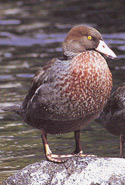 |
|
The endemic New Zealand scaup is the country's smallest duck, and only true diving duck. Its' distribution is fragmented on lakes and lagoons throughout the North Island, and is more commonly found on the shores of Lake Taupo and the Rotorua Lakes. Scaup are widely spread in the west of the South Island, including sub-alpine lakes. Scaup declined in the mid-19th century, but the population has recovered and is increasing with complete protection since 1934.
 See more See more |
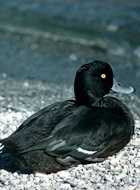 |
|
The grey duck, New Zealand's endemic subspecies of Pacific black duck, is critically endangered but still hunted. Once commonly found in wetlands and streams, and sometimes in estuaries until the 1950s, grey duck were the main quarry of hunters, comprising 95% of the country's dabbling duck population. It declined drastically from overhunting in the mid-20th century, loss of wetland habitat, and competition with introduced mallard duck. The biggest threat is now crossbreeding with aggressive male mallards.
 See more See more |
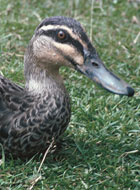 |
|
The endemic paradise shelduck is one of New Zealand's three native ducks that are unprotected and still hunted. Maori and European settler hunting almost led to near extinction, however, they came back through hunting control, and the shelduck's adaptation to pasture grazing raised the population to 120,000 by the early 1980s. 'Parries' are one of the few native species to benefit from conversion of forest to pasture. Unfortunately, some farmers regard them as a pest because of flock grazing.
|
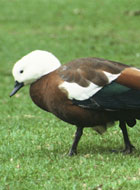 |
|
The New Zealand shoveler is the endemic subspecies of the Australasian shoveler A. rhynchotis. It is the fastest flyer of all waterfowl. The male is New Zealand's most handsome duck, with variegated, colourful plumage. It is one of the few native birds that is not protected, with about 30,000 birds shot during the duck hunting season each year. The edges of the shoveler's large wedge shaped bill have fine growths called lamellae, that sieve soft food from the water surface and even through mud.
 See more See more |
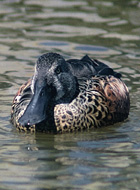 |
|
Merganser were first seen by explorer Jules d'Urville during his 1840 subantarctic voyage. Bones have been identified from South Island and Stewart Island coastal dunes and Maori middens. After extinction on the mainland, it survived on the bleak but beautiful Auckland Islands. The population declined after pigs were introduced to the islands in 1807, and cats in 1820. Since 1840, 26 were killed for collections before the last known pair were shot in 1902 by the Earl of Ranfurly, Governor of New Zealand.
 See more See more |
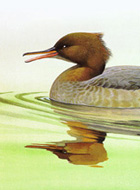 |
| |
 |
| |
 |
|
2008 IUCN Red List of Threatened Species
Blue duck
Hymenolaimus malachorhynchos
Endangered
Campbell Island teal
Anas nesiotis
Critically endangered
Brown teal
Anas chlorotis
Endangered
Auckland Island teal
Anas aucklandica
Vulnerable
|
| |
2005 New Zealand Threat Classification System
Blue duck
Hymenolaimus malachorhynchos
[B.3] Nationally vulnerable
Grey duck
Anas superciliosa superciliosa
[B.1] Nationally critical
Campbell Island teal
Anas nesiotis
[B.1] Nationally critical
South Island brown teal
Anas chlorotis 'South Island'
[B.1] Nationally critical
Brown teal
Anas chlorotis 'North Island'
[D.2] At risk-recovering
Auckland Island teal
Anas aucklandica
[B.3] Nationally vulnerable
New Zealand shoveler
Anas rhynchotis variegata
[E] Not threatened
Paradise shelduck
Tadorna variegata
[E] Not threatened
New Zealand scaup
Aythya novaeseelandiae
[E] Not threatened
Grey teal
Anas gracilis
[E] Not threatened |
| |
Extinct ducks, geese and swans .....
Auckland Island merganser
Mergus australis
Blue-billed duck
Oxyura australis
New Zealand musk
(De Lautour's duck)
Biziura delautouri
Chatham Island duck
Pachyanas chathamica
Finsch's duck
Chenonetta finschi
Scarlett's duck
Malacorhynchus scarletti
North Island goose
Cnemiornis gracilis
South Island goose
Cnemiornis calcitrans
New Zealand swan
Cygnus sumnerensis |
| |
| |
Photo and image credit:
Center top; Blue duck, Copyright © Geoff Moon
Center 2nd down; Grey duck, R. Sutton, Crown Copyright © Department of Conservation
Center 3rd down; Paradise shelduck pair, Rod Morris, Crown Copyright © Department of Conservation
Center 4th down; New Zealand shoveler male, J.L. Kendrick, Crown Copyright © Department of Conservation 1971
Center 5th down; New Zealand scaup male, Peter Morrison, Crown Copyright © Department of Conservation 1971
Center bottom; Auckland Island merganser, Permission of Peter Schouten |
| |
|


